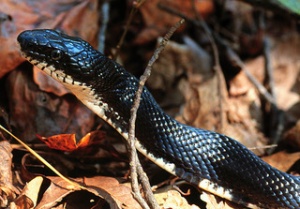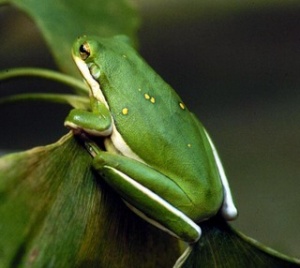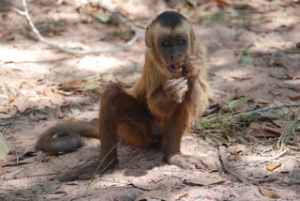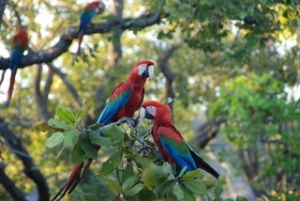Biology of the Vertebrates
EEB 2214
Fall 2008
Contents
- 1 KEY TO EXAM 2 IS NOW POSTED in the hallway outside Dr. Rubega's office, Rm 500 of Pharmacy/Biology Building
- 2 Instructors
- 3 Grading
- 4 Vertebrates in the News
- 5 Link to Tutorial, Practice Quiz, and Study Guide
- 6 Review Session Information and Additional Office Hours
- 7 Questions (from students) and Answers (note: I will respond to questions received up to, but not after, Monday 10 November, at 5 p.m.)
- 8 Lecture Schedule, Review Questions, and Video Links
KEY TO EXAM 2 IS NOW POSTED in the hallway outside Dr. Rubega's office, Rm 500 of Pharmacy/Biology Building
This course will cover the diversity of vertebrates and the evolution of form and function within this group.
Meetings: Tuesdays and Thursdays, 12:30-1:45 in BSP130
Textbook: Pough F. H., C. M. Janis, and J. B. Heiser. 2005. Vertebrate Life, 7th Edition. Prentice Hall.
Instructors
Dr. Elizabeth Jockusch
Office: Biology/Pharmacy 305B
Phone: 486-4452
E-mail: elizabeth.jockusch@uconn.edu
Office hours: Tuesdays, 2-3 pm, and by appointment
Dr. Margaret Rubega
Office: Biology/Pharmacy 500
Phone: 486-4502
E-mail: margaret.rubega@uconn.edu
Office hours: by appointment
Maria Pickering (teaching assistant)
Office: Torrey Life Sciences 480
Phone: 486-1882
E-mail: maria.pickering@uconn.edu
Office hours: Thursdays, 3-4 pm, and by appointment
Grading
Exam 1 30% (100 points)
Exam 2 30% (100 points)
Final Exam 40% (133 points)
There will be two one-hour, non-cumulative, exams scheduled during the lecture hour. The two-hour final will be split into two parts: the first part will cover all material since the second exam, and the second part will be a comprehensive (cumulative) exam covering the entire course.
Missed exams and Concerns about Finals![]()
Any student who does not attend an exam and fails to receive permission in advance will receive a 0 for the exam. Approval of any request to miss an exam requires, but is not guaranteed by, verifiable written documentation of the reason. A student who receives approval to miss an exam will, at the discretion of the instructor, either take a make-up exam or have his or her course grade prorated based on performance in the remainder of the course.
Academic integrity
Plagiarism and cheating are violations of the student conduct code, and may be punished by failure in the course or, in severe cases, dismissal from the University. For more information, see Section IV of the Student Conduct Code available at the web site of the Dean of Students.
Disabilities
If you have a disability for which you may be requesting an accommodation, you should contact a course instructor and the Center for Students with Disabilities (Wilbur Cross Building, Room 201) within the first two weeks of the semester:
Vertebrates in the News
Tiktaalik Article
Mammals Threatened with Extinction
New Feathered Dinosaur Discovered
Bat Disease Fungus Identified
Marine Protected Areas Proposed
New Turtle Fossil with Partial Shell
Link to Tutorial, Practice Quiz, and Study Guide
Go through the powerpointPHYLOGENY TUTORIAL and then test your tree knowledge with this PRACTICE QUIZ![]()
Practice Quiz Answers![]()
Study guide for Exam 1![]()
Practice Multiple Choice Questions![]()
An answer key for exam 1 is posted outside of Dr. Jockusch's Office, BioPharm 305B.
Review Session Information and Additional Office Hours
REVIEW SESSION FOR THE FINAL EXAM will be held on FRIDAY, DEC. 5th, 4-6, BPB130
- Additional Office Hours on MONDAY, DEC. 8: Maria 11-1pm
Questions (from students) and Answers (note: I will respond to questions received up to, but not after, Monday 10 November, at 5 p.m.)
What exactly is this difference in the pubis orientation between ornithischians and saurischians? This is illustrated, and better looked at than described, in Fig. 16.8 in your book, and in at least one of the diagrams on the handout from the dinosaur lecture.
In the lecture on Pterosaurs we discussed Pterosaurian adaptations to flight and hollow bones were given as an example. How can this be if hollow bones are a synapomorphy for Theropoda, which comes later in the tree?
This is an excellent question, and points out the issue of using certain morphological features to define groups when convergence may cause those features to arise in multiple places, independently, on a phylogenetic tree. The shortest answer is that hollow bones arose independently in the Pterosauria and then later in the Dinosauria; and thus hollow bones are useful for distinguishing Theropods from other Dinosauria -- they are a synapomorphy within the Dinosauria part of the tree, but require more careful definition in the larger Vertebrate tree to be useful as a group-defining characteristic.
What types of morphological features and synapomorphies do we need to know for sauropodomorpha, tyrannosaurids, ornithomimids and manirapturians as separate groups? You need to know all the synapomorphies that were given AS synapomorphies for any group (e.g. Sauropodomorpha) defined in class by synapomorphies. These will generally appear on the handouts provided in class on slides titled, "Synapomorphies of...." For groups where characteristics were given, but synapomorphies not listed (e.g. Maniraptorans -- note the spelling, which counts), you need to know which morphological features were important in an evolutionary sense -- e.g., in Maniraptorans, swiveling shoulder and hand joints made the evolution of flight in birds possible, by making the arm movements that would become necessary for flapping flight possible).
Is the palatal valve a synapomorphy for crocodiles? The palatal valve is a feature of the soft-tissue found in all living crocodylians. Because we can't be sure of soft-tissue morphology in extinct forms, we can't say for sure that it's a synapomorphy for the whole group, but it is an important feature that allows crocodiles to breathe when most of their bodies are underwater.
Is the perforate acetabulum a dinosaur synapomorphy or specifically a saurischian synapomorphy? The perforate acetabulum is a DINOSAUR synapomorphy.
what exactly does the term food caching mean? Does it involve the movement of the head that the bird uses to get its food? Then with the tool use I have that the Bristle-thighed curlew throws rocks at the eggs to break and that the New Caledonian crows us "handedness" but I'm not clear on that term either. Food caching is a behavior in which the animal stores food for consumption at a later date, sometimes by burying it, sometimes by other means. I gave Acorn Woodpeckers, who make holes in dead trees to store acorns, as an example. Both curlews and New Caledonian crows use tools -- the curlews use rocks, and the crows use twigs as probes -- but the New Caledonia crows exhibit handedness the way a human does; individuals always hold the twig either to the left or right to use it, in the same way an individual human always uses either their left or right hand to manipulate a tool.
What should we know about the Darwin's finches experiments? I am assuming it will be in terms of their implications on the importance of beak shape to feeding... just that each species has a highly specific, highly adapted beak form to one certain type of food, and that this specificity was demonstrated when some species died off in the drought periods when their usual food source disappeared? The first thing to know about Darwin's finches are that they don't represent any experiment in the sense of a human manipulation of conditions to test an idea. The diversity of beak shapes among Darwin's finches were an important hint to Charles Darwin about how differences among closely-related animals might evolve. The populations of these birds, over the last 50 years or so, has also served to provide a real, ongoing test of the idea that evolution happens through natural selection. As conditions have changed on the Galapagos islands, where the birds live, the beak shape that works best on the food available under those conditions changes, and we have seen that the prevalence of one kind of beak or another changes as conditions change. When hard seed are all that's available, beaks that are good for hard seeds become more common, as the birds with beaks good for softer seed fail to survive.
I have a question about the phylogeny of birds. I understand that birds evolved from the therapod group and the therapod dinosaurs broke up into the tyrannosaurids, ornithomimids and manirapturians, but I am confused about which group exactly gave rise to birds.
The Maniraptoran (note the spelling, which counts) theropods gave rise to birds.
is polygyny the most common mating system among birds or is that just the most common polygamous mating system? Polygyny is the most common form of polygamy; the most common mating system in birds overall is (social) monogamy.
Is promiscuity is the most rare condition? Yes.
a synapomorphy for birds doesn't include feathers....because we think its actually a synapomorphy for theropods? It isn't a synapomorphy for birds because animals that we don't define as birds have feathers. Whether it is a synapomorphy for all theropods depends on two things: 1)was it present in all lineages of theropods? and 2) was it absent in all other lineages of archosaurs? We lack the fossil information we'd need to answer those two questions definitively, but feathers are beginning to look widespread in the Theropoda, so may eventually be considered a synapomorphy for that group.
when did most of the neornithin(e) lineages come about? Most of the modern orders of birds arose about 60 million years ago.
and 5-10 mya that most modern genera were around? yes.
What was the advantage/significance of the phytosaur's nostrils being located so high on its head? Does it indicate something about their terrestrial lifestyle? The present position of nostrils on extant crocodylians --- on the tip of their snout -- along with their secondary palate, allows them to be entirely submerged, except for the nostrils, and still breathe. The phytosaur's nostril position, which would require most of the head to be out of any water if the animal was to breathe, is just one of several morphological hints that it was more, and perhaps completely, terrestrial.
What was the name of the gigantic crocodylian ancestor we talked about in class?
I showed you pictures of the skulls of Deinosuchus and Sarchosuchus, both of which were very large.
In terms of Pterosaurs form of flying (flapping vs. gliding), the location of wing attachment varies and may indicate flight form. Should we extrapolate that attachment closer to the foot (ie. a larger wing base)would assist in gliding, while a more narrow wing assists in active flapping? The relationship of wing area and shape to flight style are more complicated than this question would imply. For instance, albatrosses (a kind of bird) have extremely long, narrow wings, not wide ones, but they glide almost all the time. The size (especially weight) of the body in relation to total wing area is an important factor, so in each case, you'd have to know that to make a decision for a particular pterosaur. In general, though, a large wing area in relation to body weight increases the animal's capacity to glide without having to flap.
The morphological diversity of pterosaurs was said in lecture to indicate they were also "ecologically diverse". What exactly does this mean?
It means that they inhabited a wide range of kinds of habitats, and made a living in a wide range of ways: eating different foods, living up in trees, or down on the ground, living near the water or far away.....
Were the giant sauropods endotherms or ectotherms? We talked in class about the body heat probably produced by their liver while making all the enzymes necessary to break down their food; does this indicate homeothermy? It would be hard to shed that amount of heat.
No one knows for sure if the giant sauropods were endotherms or ectotherms. In this case your notes have misled you; we talked in class about how, IN ENDOTHERMS, body heat is produced by enzymes produced by the liver, but we don't know that this happened in sauropods. We did talk about how muscle activity, in both endo- and ectotherms, makes waste heat that is lost easily in small animals, not lost so easily in big animals. In any case, a big animal like a sauropod would have had a somewhat stable body temperature just because it was big, and therefore didn't lose heat very rapidly.
should I focus more on the notes and handouts or possibly the readings in the textbook for Tuesday's exam? In general, you should certainly have a strong grasp of the notes and handouts from lecture, and use them as a guide to what is most important in the textbook. So, for instance, if I told you in class to ignore a diagram in your book, you'd want to ignore it; if I lecture for 3 days on dinosaur relationships, you want to know the textbook material on dinosaur relationships, as well as the notes, pretty well.
I was wondering if we have to know the relationships within Paleognathaes and Neognathaes for the exam. If there is a grey box printed over the names on your handout, you don't need to know the relationships among them. If there isn't, you do. Thus: you need to know the two major groups in the paleognathae (Tinamiformes and Struthioniformes) but not the groups inside the Struthioniformes.
what exactly is a pair bond?
It is a social association of two individuals for the purposes of reproduction. Thus, two birds who spend time together defending a territory where they will build a nest have a pair bond; two birds who travel together in the same feeding flock in the winter do not.
Were pterosaurs the first vertebrates to gain the ability of powered flight? Yes.
How does the pevlic arrangement differ between ornithischia and saurischia (I understand the pubis orientation but I got confused with pelvis The pelvis consists of three principle bony elements: the ischium, the ilium and the pubis. What differs about the pelvis between ornithischian and saurischian dinosaurs IS the orientiation of the pubis. There is also some difference in the overall shape of the ilium, in that in ornithischian dinosaurs, it has a more elongated anterior (front) projection.
what is the relationship between body size and herbivory (bigger animals are herbivores?) In general, in order to perform successfully as a herbivore, an animal must be relatively large bodied, because plants are difficult to digest, and therefore have to be held in the gut (stored inside the body) for longer. A large gut, with lots of storage space, requires a large container. This does not preclude predators from growing very large -- a blue whale is a predator, not a herbivore --- but it does mean that dedicated herbivores cannot be small.
synapomorphies of birds which distinguish them from arch. and non avian dinosaurs (is that the keeled sternum, pygostyle, etc.?) Synapomorphies of birds include: a pygostyle, fusion of the hand elements, a keeled sternum, and a toothless beak. At one time the list would have included feathers, but we now know that a number of other theropod dinosaurs which we would not consider birds had feathers, so feathers cannot uniquely identify birds among the dinosaurs.
WAIR- i'm confused about how it is a theory of flight; is it that they flap to climb but then they use it to fly? WAIR (Wing-assisted incline running) is an actual behavior exhibited by many species of birds: when they are chased up a slope, they climb or run up it by using their wings in a flapping motion that increases the traction of their feet against the slope. We think about it as a theory of flight in that it illustrates, directly, one way in which we can envision how a ground-dwelling theropod dinosaur could have benefited from limb motions and an increase in the surface area of the limbs; once the motions and the surface area had been enhanced through natural selection (because they were good for tree-climbing) then they were available (and happened also to be useful) for generating lift to get off the ground and fly.
What was the reason for birds having higher body temperatures? I remember the causes of this, such as needing to feed often, but I don’t know what the cause of it is. An excellent question: did the warm body temperatures cause the need to feed often (if you are burning energy all the time, you need to keep feeding the furnace), or did warm body temperatures evolve because of the advantages of being warm all the time for an active predator? We don't know what came first: we know there is an association between being an active predator and being warm-bodied (i.e., able to move around quickly at any time), and between being warm-bodied and high feeding rates. There is also an association between being very warm-bodied (as birds are) and being small (as birds are, in general) that results from the higher rates of heat loss for a small animal than for a large one.
What were the things that helped diversify feeding? I got loss of teeth and flight allowed them to go into any habitat, but I don’t have the third.
An additional factor is that the jaws are covered with a rhamphotheca, a continuously-growing horny covering that is more easily modified in shape than are the underlying bones.
Lecture Schedule, Review Questions, and Video Links
| Date | Instructor | Topic | Readings | |
|---|---|---|---|---|
| Aug. 26 | Jockusch | Vertebrate diversity Salamanders Feeding Marine Iguana Running Komodo Dragon Walking |
--- | |
| Aug. 28 | Jockusch | Chordates and vertebrate origins |
Ch. 1, Ch. 2 | |
| Sept. 2 | Jockusch | Living jawless vertebrates Hagfish Sliming |
pp. 48-53 | |
| Sept. 4 | Jockusch | Early vertebrate fossils |
pp. 43-48, 53-71 | |
| Sept. 9 | Jockusch | Chondrichthyans Shark Mating Whale Shark Feeding Manta Ray Feeding Eagle Ray Feeding |
Ch. 5 | |
| Sept. 11 | Jockusch | Actinopterygians Paddlefish Feeding Moray Eel Eating Listen to a Black Drum |
pp. 124-150 | |
| Sept. 16 | Jockusch | Fish conservation Leafy Seadragon Babies Hatching Mangrove Killifish in Log Pictures of Deep Sea Fishes Bottom Trawling |
pp. 150-155 | |
| Sept. 18 | Jockusch | Fish conservation, Sarcopterygii Guide to Sustainable Seafood Choices-- |
pp. 118-124 | |
| Sept. 23 | Jockusch | The origin of tetrapods |
pp. 196-210 | |
| Sept. 25 | Jockusch | Lissamphibian diversity Salamander Courtship--Headslap Salamander Sperm Transfer Chinese Giant Salamander (Andrias) Frog Eats Frog |
Ch. 10 | |
| Sept. 30 | Jockusch | Exam 1 | ||
| Oct. 2 | Jockusch | Lissamphibian diversity continued Frog defenses-In Snake's Mouth Escape Hatching from Snake Attack |
Ch. 10 | |
| Oct. 7 | Jockusch | Amniote diversity/desert adaptations |
pp. 327-336, 341-374 | |
| Oct. 9 | Jockusch | Evolution of snakes Heat Avoidance in Desert Chameleon Horned Lizard Defense (Spurting Blood!) Snake Jaw in Action |
pp. 336-341 | |
| Oct. 14 | Rubega | Turtles Kemp's Ridley turtle digging a nest Kemp's Ridley turtle laying eggs Kemp's Ridley turtle eggs hatching Kemp's Ridley turtle hatchlings making their way to the sea after hatching |
Ch. 12 | |
| Oct. 16 | Rubega | Diapsids: Archosaurs; Crocodilians Crocodile Parental Care || pp. 397-407 || | ||
| Oct. 21 | Rubega | Archosaurs: Pterosaurs to Dinosaurs |
pp. 407 - 436 | |
| Oct. 23 | Rubega | Dinosaurs II |
pp. 407-436 | |
| Oct. 28 | Rubega | Birds: Avian origins Wing-assisted Incline Running in birds WAIR in a variety of birds |
pp. 426-436 | |
| Oct. 30 | Rubega | Birds: Feeding Crows use cars as a feeding tool! |
pp. 458 -463 | |
| Nov. 4 | Rubega | Birds: Morphology and Reproduction |
pp.443-448, 453-458, 463-478 | |
| Nov. 6 | Rubega | Birds: Reproduction Australian Bowerbird Behavior |
Chap 18 | |
| Nov. 11 | Rubega | Exam 2 | ||
| Nov. 13 | Rubega | Mammals: Diversity |
pp. 519-543 | |
| Nov. 18 | Rubega | Mammals: Morphology and Behavior |
Ch. 21 | |
| Nov. 20 | Rubega | Mammals: Primate evolution and human origins |
Chapter 24 | |
| Dec. 2 | Rubega | Mammals: Primate evolution and human origins continued |
Ch. 24 | |
| Dec. 4 | Rubega | Vertebrate mass extinctions, past and present; Vertebrate Conservation | pp.663-671 ; 671-687 | |
| Dec. 5 | Maria | Review Session, 4-6pm, BSB 130 | ||
| Dec. 8 | Final Exam 3:30-5:30 pm (TENTATIVE) |



